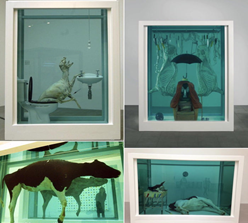

Context
An exhibition titled Natural History at Gagosian Gallery in London brings together the famous formaldehyde sculptures.
About
About Damien Hirst:
- Damien Hirst is United Kingdom’s richest living artist.
- He has produced some of the most controversial artworks of recent years, which includes the much-debated series of formaldehyde sculptures with dead animals.
- He became the main organiser of the group’s exhibition; ‘Freeze’ that took place in 1988and caught the attention of British advertiser and collector Charles Saatchi.
- Following his purchase of A Thousand Years, Saatchi had offered to finance any piece of art that Hirst wanted to create.
- The result was ‘The Physical Impossibility of Death in the Mind of Someone Living’, a tiger shark pickled in formaldehyde in a glass case, which was exhibited in 1992 as part of the first Young British Arts (YBA).
Criticism:
- Though Hirst’s works using animals have been criticised by animal rights activists, the global art market itself is divided.
- While some animals were dead before Hirst decided to use them, others were killed for his art.
- In 2012, Hirst’s exhibition In and Out of Love at Tate Modern had two windowless rooms filled with live butterflies, later reported that more than 9,000 butterflies died during the 23-week exhibition.
- In 2017, the art market website artnet estimated that Hirst had used almost one million animals for his works.
About Formaldehyde:
- Formaldehyde is a colorless, strong-smelling, flammable chemical that is produced industrially and used in building materials such as particleboard, plywood, and other pressed-wood products.
- Uses of formaldehyde:
- When formaldehyde is dissolved in water, it is called formalin. This formalin is used as a disinfectant in industries, preservative in some food products, funeral home etc.
- Used in industry
- Used in medicine
- Used in building and construction
- Food and other uses
- Formaldehyde is found in:
- Resins used in the manufacture of composite wood products (i.e., hardwood plywood, particleboard and medium-density fiberboard);
- Building materials and insulation;
- Household products such as glues, permanent press fabrics, paints and coatings, lacquers and finishes, and paper products;
- Preservatives used in some medicines, cosmetics and other consumer products such as dishwashing liquids and fabric softeners; and
- Fertilizers and pesticides.
- It is a byproduct of combustion and certain other natural processes, and so is also found in:
- Emissions from un-vented, fuel burning appliances, like gas stoves or kerosene space heaters
- Cigarette smoke


